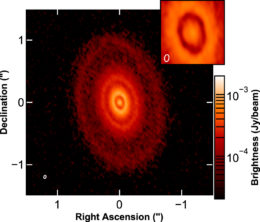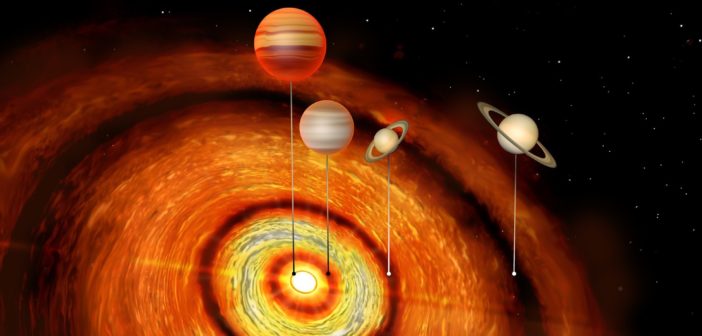Blistering hot, giant planets zip around many stars similar to the Sun. New observations of one such planet — likely surrounded by a set of three gas-giant siblings — is now raising questions about the formation of giant planets.
Birthing a Hot Jupiter
Hot Jupiters — gas giants orbiting their hosts at radii of < 0.1 AU — are thought to orbit around 1% of main-sequence solar-type stars. In spite of the many hot Jupiters we’ve discovered, however, we still don’t fully understand how these toasty giants form. Are they born and evolve in situ, alongside their host? Or do they develop further out in the early protoplanetary disk of gas and dust surrounding a young star, and migrate inward later in their lifetimes? What role might outer gas-giant siblings play in this process?

Synthesized image of the CI Tau continuum observations, revealing three annular gaps between 10 and 100 AU. The inset shows a 0.35”-wide zoom on the innermost gap, imaged with a finer resolution. [Clarke et al. 2018]
A Unique Disk
The Atacama Large Millimeter/submillimeter Array (ALMA) is progressively building its reputation as an imager of the detailed structure within young protoplanetary disks; you might recall one of its first releases, the spectacular image of the concentric gaps and rings of the disk surrounding HL Tau.
In a new study led by Cathie Clarke (University of Cambridge’s Institute of Astronomy, UK), this groundbreaking telescope has been used to image another young star system, CI Tau, which hosts the first hot-Jupiter candidate found still within a protoplanetary disk.
Though CI Tau is roughly the same mass and luminosity as the Sun, it’s only about 2 million years old. The presence of the 11.3-Jupiter-mass giant planet in a close-in orbit in the disk therefore shows that whatever the formation mechanism for hot Jupiters, they must arrive at their close orbits very rapidly!
New Planets, New Challenges

Synthetic image of the CI Tau continuum emission produced from the authors’ gas and dust hydrodynamical simulation containing three planets. The authors’ models well reproduce the observations of the system. [Clarke et al. 2018]
If confirmed, the presence of these outer planets poses a significant challenge to our understanding of planet formation. Based on current models, the outermost planets shouldn’t have been able to accrete enough material from the outer disk in just 2 million years to reach their current sizes. And even if this mystery could be explained, another exists: the planets’ growth past a certain point should have triggered rapid inward migration.
Though the new observations of CI Tau have raised as many questions as answers, they solidify the association between close-in hot Jupiters and gas giants on wider orbits. As ALMA continues to build a census of young protoplanetary disks, we can hope that future observations will shed further light on the process of building giant planets.
Citation
“High-resolution Millimeter Imaging of the CI Tau Protoplanetary Disk: A Massive Ensemble of Protoplanets from 0.1 to 100 au,” C. J. Clarke et al 2018 ApJL 866 L6. doi:10.3847/2041-8213/aae36b


1 Comment
Pingback: AAS Nova – New